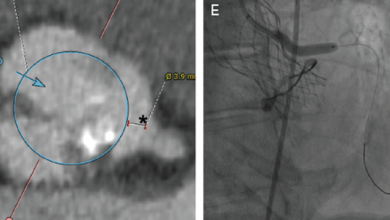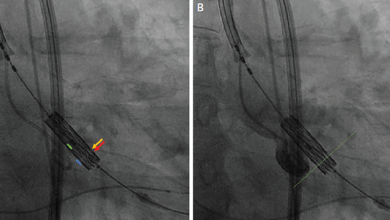Search results
PROMOTED
Author(s):
Nicolas M Van Mieghem
,
Kendra J Grubb
,
David Hildick-Smith
,
et al
Start date:
Mar 26, 2024
Author(s):
Joelle Kefer
Added:
3 years ago
Atrial septal abnormalities are common congenital lesions remaining asymptomatic until adulthood in a great number of patients. The most frequent atrial septal defects in adults are ostium secundum atrial septal defect (ASD) and patent foramen ovale (PFO), both approachable by transcatheter closure using device implantation. The first non-surgical ASD closure was performed in 1975 by Mills and…
View more
Author(s):
Christian Spies
,
Ziyad M Hijazi
Added:
3 years ago
Unlike the left-sided semi-lunar valve, clinically significant acquired pulmonary valve disease is rare. However, stenotic or regurgitant pulmonary valve lesions are not uncommon following surgery for congenital heart defects, including tetralogy of Fallot, pulmonary atresia and other surgical procedures requiring reconstruction of the right ventricular outflow tract (RVOT).1–4 Even with the use…
View more
Author(s):
Grégory Ducrocq
,
Dominique Himbert
,
Eric Brochet
,
et al
Added:
3 years ago
Aortic stenosis (AS) is currently the most frequent native valve disease in Europe and is most often seen in elderly patients with co-morbidities.1 Valve replacement is the definitive therapy for patients with severe AS who have symptoms or objective consequences such as left ventricular (LV) dysfunction.2,3 However, the risk of surgery may be higher in elderly patients with significant co…
View more
Chimney Stenting During TAVI
Author(s):
Liesbeth Rosseel
,
Michael Rosseel
,
Brian G Hynes
,
et al
Added:
3 years ago
Article
Author(s):
Simon Kennon
,
Zhan Lim
Added:
3 years ago
The main advantages of transcatheter aortic valve implantation (TAVI) over conventional aortic valve replacement (cAVR) surgery are the avoidance of sternotomy, heart lung bypass and prolonged procedure times. These advantages facilitate early mobilisation and discharge – important both clinically and in terms of resource utilisation. Balanced against this, TAVI is less predictable than cAVR –…
View more
Impact on Implantation Depth
Author(s):
Verena Veulemans
,
Oliver Maier
,
Tobias Zeus
Added:
2 months ago
Article
Author(s):
Rhys Gray
,
Kiran Sarathy
Added:
2 years ago
Author(s):
Shu-I Lin
,
Mizuki Miura
,
Ana Paula Tagliari
,
et al
Added:
3 years ago
Transcatheter aortic valve implantation (TAVI) is now established as the standard treatment for symptomatic severe aortic stenosis (AS) in patients at high or prohibitive surgical risk, and the preferred treatment for those at intermediate risk.1
Based on recent trials in low-risk patients, the indications for TAVI are expanding towards the lower-risk classes, and the procedure has even been…
View more
Author(s):
Christian Besler
,
Christopher U Meduri
,
Philipp Lurz
Added:
3 years ago
Accumulating evidence suggests that tricuspid regurgitation (TR) is independently associated with reduced long-term survival in the community and patients with ischaemic or dilated cardiomyopathy.1 Patients with moderate-to-severe TR suffer symptoms of progressive right heart failure, which are often difficult to treat with diuretic therapy. Prevalence estimates based on data from the Framingham…
View more














